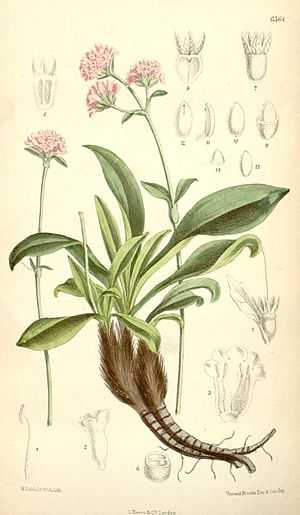Nard (plant) facts for kids
Quick facts for kids Nard (plant) |
|
|---|---|
 |
|
| Conservation status | |
| Scientific classification | |
| Genus: |
Nardostachys
|
| Species: |
jatamansi
|
| Synonyms | |
|
|
Nardostachys jatamansi is a special flowering plant that grows high up in the Himalayas mountains. It belongs to the valerian family. People often call it spikenard, nard, nardin, or muskroot.
This plant is famous for its strong-smelling, amber-colored essential oil. This oil, also called spikenard, has been used for a very long time. People used it as a perfume, in traditional medicine, and in religious ceremonies. Sadly, Nardostachys jatamansi is now an endangered species. This is because too much of it has been collected for medicine. Also, animals eating too much of the plant and its natural homes being destroyed are big problems.
Contents
About the Spikenard Plant
Nardostachys jatamansi is a flowering plant that is part of the honeysuckle family. It grows in the eastern Himalayas. You can find it mainly in areas like Kumaon, Nepal, Sikkim, and Bhutan.
What the Plant Looks Like
This plant usually grows to be about 10 to 50 centimeters (4 to 20 inches) tall. It has pretty pink flowers that look like small bells. You can find these plants growing at very high altitudes, from 3,000 to 5,000 meters (about 9,800 to 16,400 feet) above sea level.
How Spikenard Oil is Made and Used
The plant has special underground stems called rhizomes. These rhizomes can be crushed. Then, a process called distillation turns them into a thick, amber-colored essential oil. This oil has a very strong and pleasant smell.
Nard oil has many uses:
- It is used as a perfume because of its unique scent.
- It is burned as incense in many cultures.
- It can act as a sedative, which means it helps people relax.
- It is also used in herbal medicine. Some people believe it helps with sleeping problems or other small health issues.
Spikenard in History
The plant Nardostachys jatamansi is thought to be the source of the ancient incense known as spikenard. This spikenard was mentioned in old texts and used in many historical ceremonies. While Nardostachys jatamansi is a strong candidate, some people also think that lavender might have been used as spikenard in classical times.


